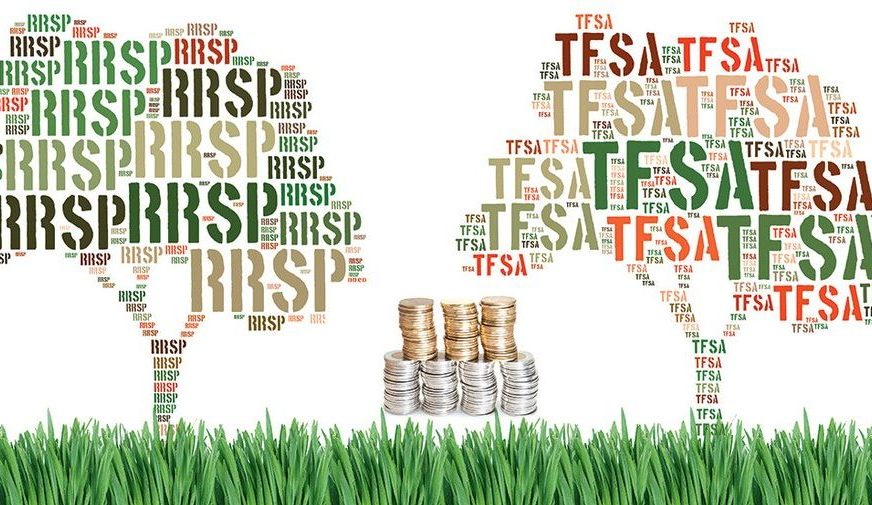THE BEST RETIREMENT-SAVINGS PLAN FOR YOU IS THE ONE THAT BEST FITS YOUR CIRCUMSTANCES
By Olev Edur
While most Canadians understand the value of RRSPs in saving for retirement, Good Times continues to receive numerous letters from readers who don’t quite understand the new kid on the savings block—the Tax-Free Savings Account (TFSA), which was introduced in 2009.
“I think a lot of the confusion comes from the name itself,” says Orville Acton, a financial advisor with Edward Jones in Weyburn, SK. “A lot of people seem to feel that because it’s called a ‘savings’ plan, you can invest only in savings-type investments such as GICs. Maybe it would have been better to call it a tax-free investment account, because it can be used for bonds, company shares, mutual funds—a whole range of investments.”
In addition to having trouble understanding TFSAs, many readers have expressed confusion about which are better—RRSPs or TFSAs—and under what circumstances one should be given preference over the other. Accordingly, the following is a brief synopsis of RRSP/TFSA strategies so that you can structure your nest egg to your best advantage now and in the future.
The key difference between the two, for retirement-planning purposes, is that RRSP contributions are tax-deductible and withdrawals are taxable, while TFSA contributions aren’t tax-deductible but withdrawals are tax-free. As such, while your savings strategies can depend on a number of factors, one basic rule emerges when it comes to deciding which of these plans is more appropriate in your particular circumstances: “In general, the choice depends on your income levels before and after retirement,” Acton says. “If you’re in the same tax bracket before retirement as when you’re retired, then mathematically speaking, you aren’t better off with either plan. With RRSPs, you get a tax break now but must pay the same amount of tax later, while with TFSAs, you pay the tax now but don’t have to pay the tax later on.
“If, however, your tax rate now is higher than it will be when you’re retired, the RRSP wins. And if your tax rate in retirement will be higher than it is now, then TFSAs are the clear winner in mathematical terms.
RRSP AND GUARANTEED INCOME SUPPLEMENT (GIS)
While the basic math is fairly simple, several other factors may come into play that can affect the decision as to which plan you should use. First and foremost, if your retirement income will be low enough that you’ll be entitled to the GIS in retirement (GIS becomes available once you reach age 65), then even if your tax rate is as low now as it will be later, TFSAs are the better option.
“If you have an RRSP and you qualify for GIS, any withdrawals from an RRSP will be added to your income, and this will reduce your GIS by 50 cents for each RRSP dollar you withdraw,” Acton says. “Withdrawals from a TFSA, on the other hand, have no effect on GIS. And the same applies to a lot of other income-tested benefits that may become available when you retire.”
There may even be cases in which it is worthwhile to deplete an RRSP before reaching age 65 and pay the necessary taxes in order to avoid that GIS clawback in future years. However, Acton says, “You need to understand the whole picture. You have to look at all the factors.”
If, for example, you’ve already amassed a sizable RRSP, then trying to deplete it before age 65 could result in an enormous tax bill that completely offsets any potential GIS savings. In this situation, all you may be able to do is try to maximize your GIS for a single year, using the provision that GIS is based on your previous year’s income.
“If you think you’ll be getting GIS at age 65, it might be best to defer your RRSP contributions until age 64 and make a big contribution that year,” says Myron Knodel, director of tax and estate planning with Investors Group in Winnipeg. “In fact, you can still contribute today and claim the tax deduction later, so you can get maximum tax-free compounding in the meantime.”
Similarly, since you don’t need to begin withdrawing money from an RRSP until you roll it into an annuity or RRIF by the end of the year you turn 71, you can at least get GIS until that age by forsaking withdrawals until that time. Of course, this strategy depends on whether or not you need that RRSP income during the interim.
Yet another point to consider: If you would otherwise be eligible for GIS but your RRSP is too big to allow for depleting it before age 65 without a huge tax hit, you can instead deplete it as soon as is practical from a tax perspective, so that eventually you will become eligible for benefits.
Knodel also suggests that if your retirement income is going to be low but you have a sizable RRSP, you may be unable to avoid the GIC clawback but can at least maximize the potential tax savings on withdrawals.
“Everyone has a basic personal exemption of about $11,000, and after reaching age 65, you may be eligible for an age credit of up to $7,000,” he points out. “So if you had no other income, you could withdraw as much as $18,000 tax-free from your RRSP each year. If you’re a couple, you could effectively withdraw up to $36,000 and pay no tax.”
In addition, it’s worth bearing in mind that RRIF/annuity payments are eligible for the $2,000 annual pension credit once you’ve reached age 65, while RSP withdrawals aren’t. So even though you aren’t required to do so until after you turn 71, you should roll some of your RRSP savings into a RRIF or annuity at age 65 so you can take advantage of that tax credit right away.
“If you have an RRSP, then you need to develop a plan for withdrawing the money as tax efficiently as possible,” Knodel says, advising that you also need to keep factors such as GIS in mind when you do your planning.
TIPS FOR THOSE WITH HIGHER INCOMES
While the foregoing strategies are aimed primarily at those with relatively low retirement incomes, other strategies can apply to those with greater resources. For example, if you have an income high enough that you’ve been using up your RRSP contribution room every year, then it makes sense to also use the TFSA to get the additional tax sheltering that both RRSPs and TFSAs provide.
There can be additional benefits to employing both plans, as well. “Retirement often entails multiple and varying goals,” Acton says. “For example, you can save with an RRSP to get the tax savings and use these to create the equivalent of a pension. But you may have other retirement goals, as well. For example, you may enjoy fishing and want to buy a fishing boat when you retire. If you have a TFSA, then you can withdraw the money for the boat without a big tax hit.”
The TFSA is particularly handy when it comes to short-term or emergency cash needs. Not only can you withdraw the money without tax consequences, but you get that same amount back as extra contribution room the following year.
“That’s a very important factor,” Acton says. “With an RRSP, if you take money out, you can’t use that contribution room again. With a TFSA, if you take anything out, you get that contribution room back—although not until the following year.” (This last point can’t be stressed enough: many people are finding themselves subject to TFSA overcontribution penalties for blithely assuming they can recontribute right away. As a result, if you want to use the money and replace it soon afterwards, then take the money out towards the end of the calendar year. That way, it can be replaced as soon as New Year’s Day has passed.)
Acton also says that the TFSA can be funded with the tax refunds you get from your RRSP contributions: “If you’re earning, say, $100,000 a year, then you can put as much as $18,000 into an RRSP and save 40 per cent in tax. Then you can take that money—maybe $7,000—and put that into the TFSA [assuming you have sufficient contribution room].”
RRSP AND TFSA—OR DEBT REPAYMENT?
One of the perennial retirement-planning questions that applies equally to TFSAs and RRSPs is whether you should pay down all your debts before thinking about socking money away into a savings plan. Unfortunately, there is no one-size-fits-all answer to this question.
“To a certain extent, it depends on the cost of the debt,” Knodel says. “If, for example, you’re paying four per cent interest on a mortgage, then you’d have to earn four per cent after tax on an investment to equal that cost. In other words, depending on your tax rate, you might have to earn six or seven per cent before tax to get that same amount after tax.”
“Debt isn’t necessarily all bad,” Acton says. “There’s good debt and bad debt, but it’s important that your debt is under control and manageable. If you have a mortgage at a low rate and it’s going to be paid off in a reasonable time, you might want to use the cash for other purposes. Or if you want to get rid of it, you could contribute to an RRSP and use the tax refund to pay down the mortgage. But if it’s a high interest credit card or loan, that’s not good debt, so it should be repaid first.
“While it’s generally advisable to get rid of debts, though, there could be a problem with doing so,” Acton continues. “If you use all your resources against your mortgage, you may not have any funds left for emergencies. If you were to lose your job, for example, you wouldn’t be able to get any of that mortgage money back from the bank, and the bank wouldn’t lend you any more money because you don’t have a job.”
Ultimately it comes down to your personal situation, and decisions like these can depend on a number of factors. In addition, there may be some additional wrinkles to the RRSP and TFSA rules that could apply in your case, such as what happens to the plan when you pass on, what other assets you have, how you prefer to invest your monies, and so on. That’s why Acton recommends seeking professional advice when it comes to planning your RRSP/TFSA/debt strategies.
“There’s no one answer for everyone,” he says. “You have to consider your retirement objectives, your resources, and how long you expect to live, and so it can get complicated. That’s why you should work with financial and tax advisors who are familiar with your circumstances and can help you develop a retirement financial plan that’s right for you.”
RRSPS AND TFSAS: THE BASIC RULES AND DIFFERENCES
RRSPS TFSAS
| Annual contribution limit |
18% of the previous year’s earned income, to a maximum of $24,270 for 2014 ($24,930 for 2015) plus any unused contribution room from prior years (see “Contribution window” below). The annual limit is reduced if contributions are made to a company-sponsored pension plan or deferred profit sharing plan. | $5,500 for 2014; the 2015 limit (if any) is expected to be announced in the federal spring budget—at press time, it was believed that the 2015 limit would increase to $10,000 annually. |
| Contribution window
|
January 1 until 60 days after the end of the year. | No time limit, since there is no tax deduction on contributions. |
| Tax treatment of contributions
|
Contributions can be deducted from present or future income.
|
Contributions have no impact on income or taxes so, as noted above, they can be made any time, subject only to the accumulated contribution limit. |
| Unused contribution room carry- forward |
Unlimited.
|
Unlimited. In addition, the dollar amount of any withdrawals from a TFSA is added back to the unused contribution room the following year. |
| Plan earnings
|
All plan savings compound tax-free. | Same as RRSPs. |
| Eligible investments
|
Most non-leveraged investments, including stocks, bonds, GICs, and mutual funds; leveraged investments such as derivatives and futures contracts generally are not eligible, nor is real estate. |
Same as RRSPs. |
| Overcontribution penalties
|
No penalty on overcontributions up to $2,000; 1% a month on amounts in excess of $2,000. |
1% a month on all overcontributions. |
| Withdrawals
|
All withdrawals are added to annual income and subject to tax at the applicable marginaltax rate.
|
Withdrawals are not considered income, so they aren’t taxable and don’t affect your entitlement to income-geared benefits such as the Guaranteed Income Supplement. |
| Lifespan
|
From age 18 until the end of the year in which you reach age 71; unless rolled into an annuity or RRIF (see “Rollover options” below), all RRSP contents are added in their entirety to that year’s income. | From age 18 onward, with no upper age limit. |
| Rollover options |
RRIFs are similar to RRSPs, except that you cannot contribute to a RRIF and must withdraw minimum amounts (based on your age) each year. Annuities provide a fixed and irrevocable income until age 90. | Not necessary, since TFSAs have no upper age limit. |
| Spousal plans
|
You can contribute to your own RRSP and/or to a plan in your spouse’s name, up to a combined total not exceeding your own contribution limit. However, withdrawals from the spousal plan within the year you contribute and the two following years may be attributed back to you and taxed in your hands. | You cannot contribute to a spousal TFSA but can give money to the spouse to contribute for him/herself, with no attribution. |






